
Scan the QR
to read the magazine on mobile phone
Editor’s note
Luye Life Sciences Group is gradually deploying the application of AI in various business sectors. To help everyone better embrace AI technology, relevant pilot projects have been successfully launched. This month, we will share with you the story behind “RPA”.
As the digital transformation of enterprises accelerates, RPA technology (Robotic Process Automation) is playing an increasingly important role in various industries. McKinsey & Company, a leading global management consulting firm, mentioned in a big data report entitled “The Digital Age: Artificial Intelligence Will Change the Fate of Enterprises” that more than 70% of the world's top 500 companies are using RPA. In 2024, the Group's Information Technology Department, Human Resources Department, and Operations Finance Department jointly established a project team to implement RPA and achieved very good results. We invited several members of the project team to explain what RPA is, and what benefits it can bring to our work.
Q: Thank you all for participating in the first employee interview of 2025. Please start by giving a brief introduction of yourself.
Kaipu: My name is Wang Kaipu. I joined Luye's IT Department in 2013 and am currently the department head. In response to the group's call for cost reduction and efficiency improvement, after preliminary research, we officially launched the RPA project in the second half of 2024.

Wang Kaipu ,Deputy Director of IT Department, Luye Pharma
Haibin: My name is Wang Haibin. I joined the company in September 2004 and am currently responsible for IT operations, production, R & D, and IT compliance in the IT Department. In this project, I am mainly responsible for communicating with and understanding the business needs of the business units and using RPA (Robotic Process Automation) tools to assist the business units in automating their business.

Wang Haibin, Manager of IT Department, Luye Pharma
Song: My name is Song Yaqi. I joined the company in July 2019 and am currently responsible for HR informatization and employee benefits in the Compensation and Benefits Department. In this RPA project, I act as a “bridge” between the HR Department and the IT Department, identifying internal departmental needs, communicating and coordinating with IT, and promoting the internal application of RPA within the department to achieve intelligent and efficient management.

Song Yaqi, Specialist of Compensation and Benefits Department, Luye Life Sciences Group
Ning: My name is Ning Xiaojing. I joined the company in August 2015 and am currently responsible for compensation and benefits, social security provident funds, and talent subsidies in the C&B Department. The RPA workflows for the housing purchase subsidy and living allowance in this project were all tailored to my work. By sorting out the process, testing the data, and adjusting and optimizations, they were finally successfully implemented.

Ning Xiaojing, Supervisor of Compensation and Benefits Department, Luye Life Sciences Group
Fang: My name is Fang Xiao. I joined the company in 2012 and currently work in the Finance Department of Conventional Medicine. I am mainly responsible for the department's financial work and OA process management. In this project, I need to find a way to combine my daily work with RPA to improve the automation of financial work.

Fang Xiao, Manager of Conventional Medicine Operation Finance Department, Luye Pharma
Q: What is the background to the establishment of the RPA project? What is the status?
Kaipu: In fact, as early as two years before the official launch of this project, we had already conducted some research on RPA. However, considering that there was a certain threshold in the practical use of such tools at that time, we did not promote it to various business departments for the time being. However, during that period, the HR department had an automation need for mass automated emails, group recognition, and daily employee birthday reminders. At that time, we used traditional automated scripting code to help them achieve their needs.
In the past two years, in response to the group's call for cost reduction and efficiency improvement, we have conducted further research on the use of RPA. With everyone's increased awareness of cost reduction and efficiency improvement, colleagues have become more proactive in using RPA as a useful tool. After rounds of communication, we started with the HR Department and the Operations Finance Department, fully sorted out the pain points of related businesses, identified many business scenarios where RPA can be implemented, and accordingly formulated process improvement plans. We utilized the features and advantages of process automation to write automated processes, which not only saves a lot of workload but also improves work efficiency and avoids the errors that may occur during manual operations. Judging from some of the business workflows that have been completed so far, it is estimated that 97% of the workload can be saved. The successful application of these automated workflows has also set a good example for the subsequent company-wide application of RPA.
After the successful implementation of RPA in the human resources and finance departments, we have also begun to contact other business units, such as Group Purchasing and R & D, to provide technical guidance on the pain points in their current work. Some departments are now able to independently carry out some processes, effectively improving work efficiency.
Haibin: Since last year, with the rising popularity of the ChatGPT, everyone has realized that this will become a trend in the future. Therefore, the IT Department has conducted relevant research on AI large models and RPA. Under the organization of the Group's HR Department, the IT Department held two sharing sessions in August and December, providing popularization and training for the entire group on the topics of AI big models and RPA, which received very positive feedback. After the training, colleagues from different departments took the initiative to contact us and began to think about and practice RPA in their work. For example, after the training, colleagues from the R & D department of Boan Biotech approached us and apply RPA to the OA procurement process. The Finance Department and Computerized System Management Department of Shandong Luye and colleagues from Nanjing Luye also actively communicated with us to find solutions to improve the efficiency of their respective departments. I am very happy that this type of training can bring benefits to everyone, and I hope to share this experience and knowledge with more departments in the future.
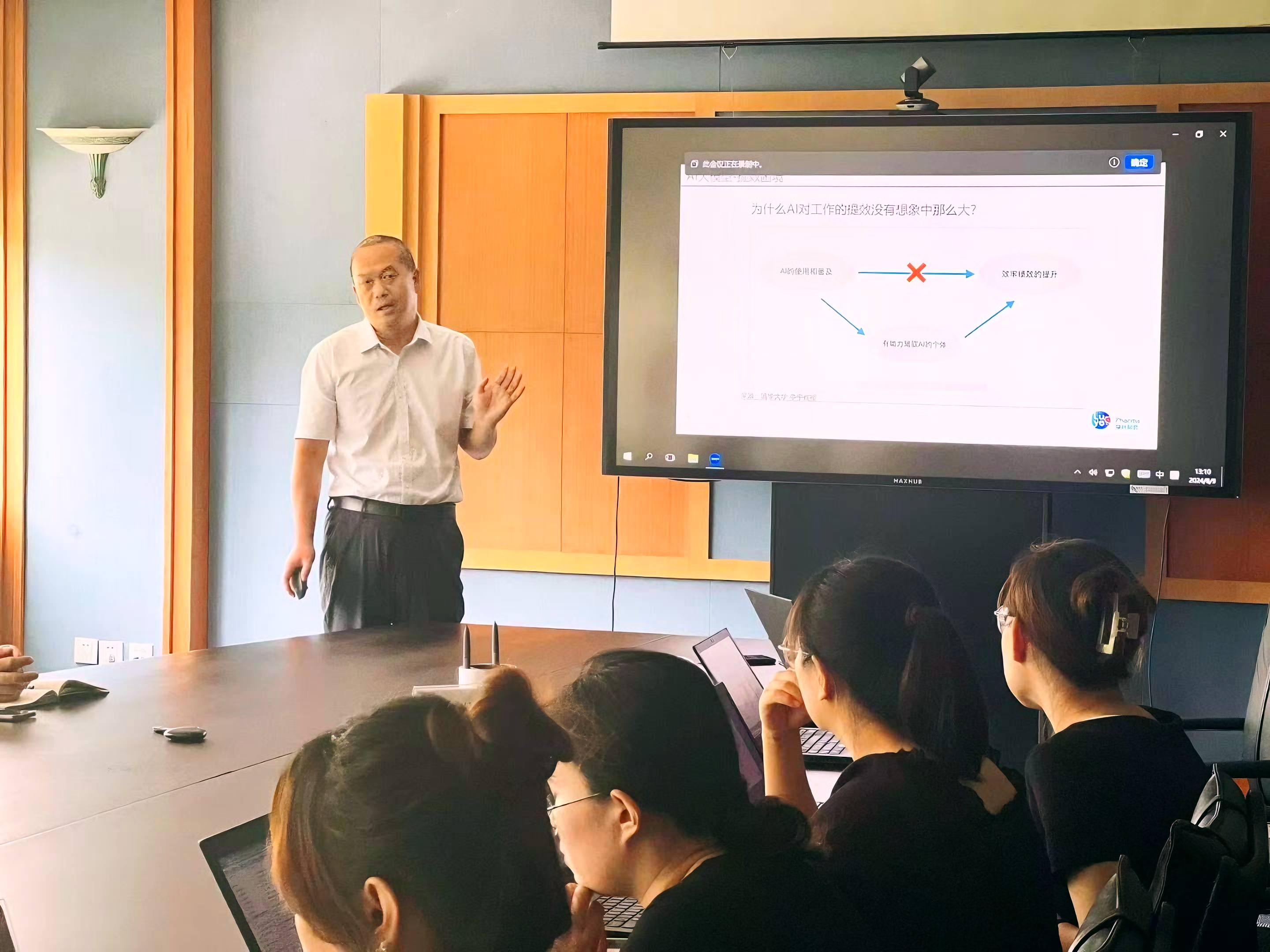
Wang Haibin at the sharing session
Q: What is RPA? How does it help us work more efficiently?
Haibin: RPA is short for Robotic Process Automation, also known as software robots. We can think of them as human hands and feet, which we can direct to perform work on the computer. RPA is suitable for simple and repetitive tasks performed on the computer, tasks that are prone to human error, 7*24-hour work, and the collection and entry of information across systems. For example, if we need to enter data from system A into system B, or enter Excel data from system B into OA, we can do it automatically through RPA.
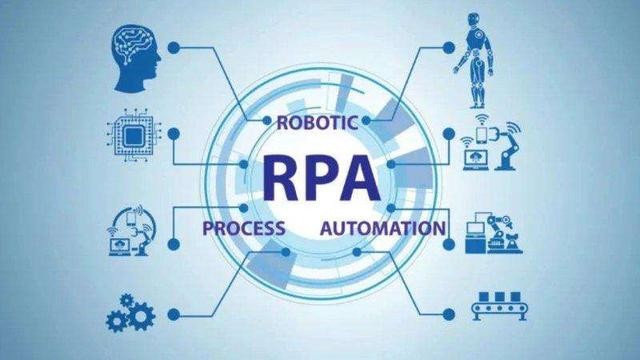
It should be emphasized that RPA is different from AI's large models. RPA can only replace human hands and feet but does not have the ability to think. Kai Pu and I have also discussed this issue. In the future, is it possible to combine RPA with large AI models such as DeepSeek to form a more complete system that can further assist the daily work of more departments? At present, we have already made initial explorations in this area. For example, when the HR Department reports personal income tax, we used an RPA+AI model to automatically verify the data returned from external systems with the reported data from our side. This is a preliminary attempt, and we hope to have the opportunity to expand on it in the future.
Kaipu: There are many RPA tools on the market today. When selecting and promoting this tool, we need to consider its stability, the supplier's technical strength, market share, and prospects. Therefore, we chose Microsoft PowerAutomate, a member component of the Microsoft Power Platform product family. This RPA tool occupies a very important position in Microsoft's entire product line. Microsoft hopes that users will regard it as a necessary basic tool. For example, when you want to make a table, naturally you will think of using Excel. Currently, Microsoft's Win11 system already comes with this tool, so there is no need to install it separately.

Microsoft PowerAutomate
Q: Combining the actual situation of the HR Department, what are the pain points in your past work? What improvements has RPA brought to your work?
Ning: Our department is responsible for payroll and social security payment for more than 40 companies. The work is highly repetitive, the data volume is large, and information verification is cumbersome. I am responsible for managing the social security fund system of 23 companies in Yantai, which requires frequent logins to the social security system, regular payments, and review of talent subsidies. Each year, I need to manually approve more than 1,000 people, which is time-consuming and laborious, and I cannot ensure timeliness. After RPA was launched, I only need to start the process with one click every day, and the robot will automatically complete the subsidy review of 23 companies and send me the approval results by email. It can quickly assist employees in applying for government subsidies, greatly improve employee satisfaction, and save 99% of the workload, so that I have more time to focus on more valuable work.
In addition, RPA also automatically initiates the salary and welfare payment process on OA. Every month, before paying salaries and social security, we need to manually initiate more than 100 OA payment processes. With the RPA process, we only need to prepare the relevant data and forms offline. After starting RPA, with one click, the robot automatically initiates the payment process. This has greatly improved work efficiency and accuracy and can save 99% of the workload.
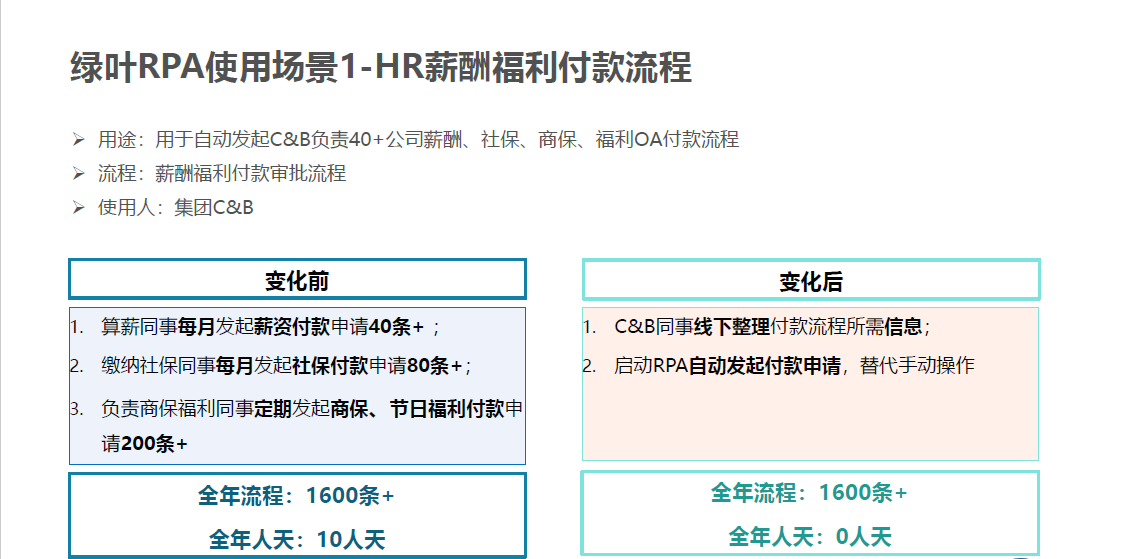
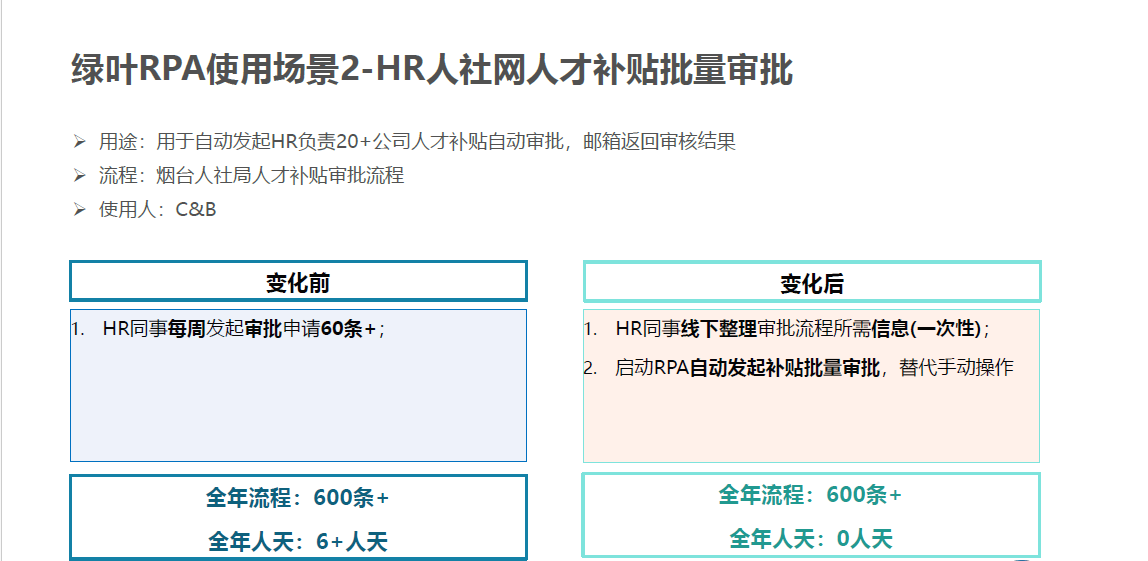
The application of RPA in HR Department (before and after)
Currently, the IT Department is assisting our department in optimizing the processes for mass additions and removals of social insurance and medical insurance and individual income tax returns. We look forward to RPA continuing to bring even greater benefits to our work in the future.
Q: Yaqi, as the HR department's coordinator for this project, what have you gained and learned in the process? What more can RPA do to help your department in the future?
Song: I have gained a lot from participating in this project. First, identifying needs requires a detailed understanding of each business process and identifying pain points. By thoroughly sorting out the workflows within my department, such as payroll, tax filing, social security contributions, subsidy applications, etc., I have gained comprehensive and intuitive understanding of the workflows in the department. This not only helped me communicate the needs of the department to the Haibin more effectively and ensured the precise application of RPA technology, but also greatly promoted my personal growth.
Second, I majored in statistics during college and have a basic knowledge of programming languages such as Python and C++. In the process of this project, I would like to thank Kai Pu and Hai Bin for their careful guidance. They not only provided us with comprehensive basic training, but also disassembled complex problems one by one, explaining in detail the functions and implementation methods of each step. Not only did it broaden my technical horizons and give me a grasp of the fundamentals of RPA, but I also gained a deep appreciation for the importance of effective communication in cross-departmental cooperation. This valuable experience has not only ensured the smooth progress of our current projects but has also laid the foundation for future in-depth cooperation with the IT Department.
Finally, participating in this project has made me realize the importance of continuous learning and self-improvement. We need to take the initiative to learn new knowledge and skills constantly in order to keep up with the times, overcome work difficulties, enhance personal competitiveness, achieve personal growth and improve departmental efficiency.
Q: As the coordinator of the Finance Department in this project, what were the pain points in your department's previous work? How has RPA changed your work?
Fang: Our financial work involves invoice entry. In the past, this type of work was handled in a one-off manner at the end of the month. It is a mechanical, repetitive and large amount of work that takes a certain amount of time to complete within a prescribed time limit, and there are high requirements for data accuracy. However, in practice, there are bound to be problems with completely relying on manual entry.
With the introduction of RPA technology, our working methods have been improved. For invoices with simple entries, the previous method has been changed to a daily sorting + end-of-month RPA entry mode. In other words, when we review invoices daily, we can first use Excel to review and sort the basic data, and then at the end of the month, RPA will enter the data, which effectively improves work efficiency and accuracy.
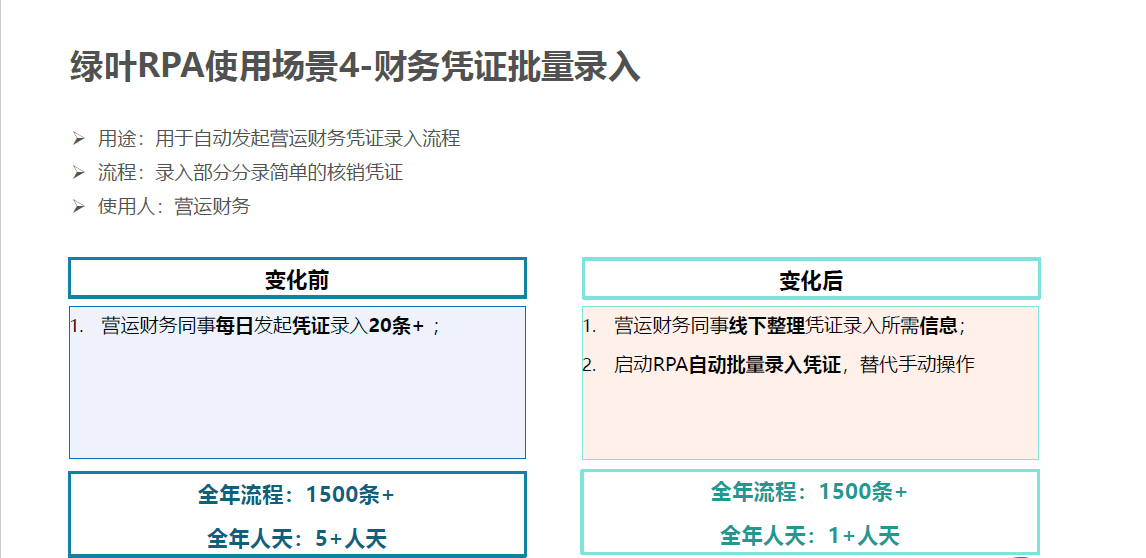
The application of RPA in Finance Department (before and after)
Q:Does the IT Department have any ideas or plans for the future development and promotion of this project?
Haibin: We hope to explore the further application of RPA in the future in two stages. We are currently in the first stage, which is to use RPA as a “work assistant” for individual employees. The focus of this stage is to use RPA to free each employee from tedious and repetitive tasks so that they can do more valuable work. In the future, the second phase of work is to establish a “digital employee” in each department. This digital employee is responsible for completing the tedious and repetitive work of the entire department. Take the HR Department as an example. We can centralize the work that is currently being assisted by individual HR colleagues using RPA and then use RPA to replace this HR colleague to complete this work, so that the HR Department has a digital employee. Similarly, it is hoped that each department will have a digital employee to perform the simple, repetitive and large amount of work in their department.
Second, as I mentioned earlier, RPA is a robotic process automation tool that can only replace human hands and feet but does not have the thinking ability. In the future, we hope to combine RPA with large models such as DeepSeek or ChatGPT, which can think, identify, and reason logically, to make digital employees smarter and thus complete more complex tasks.
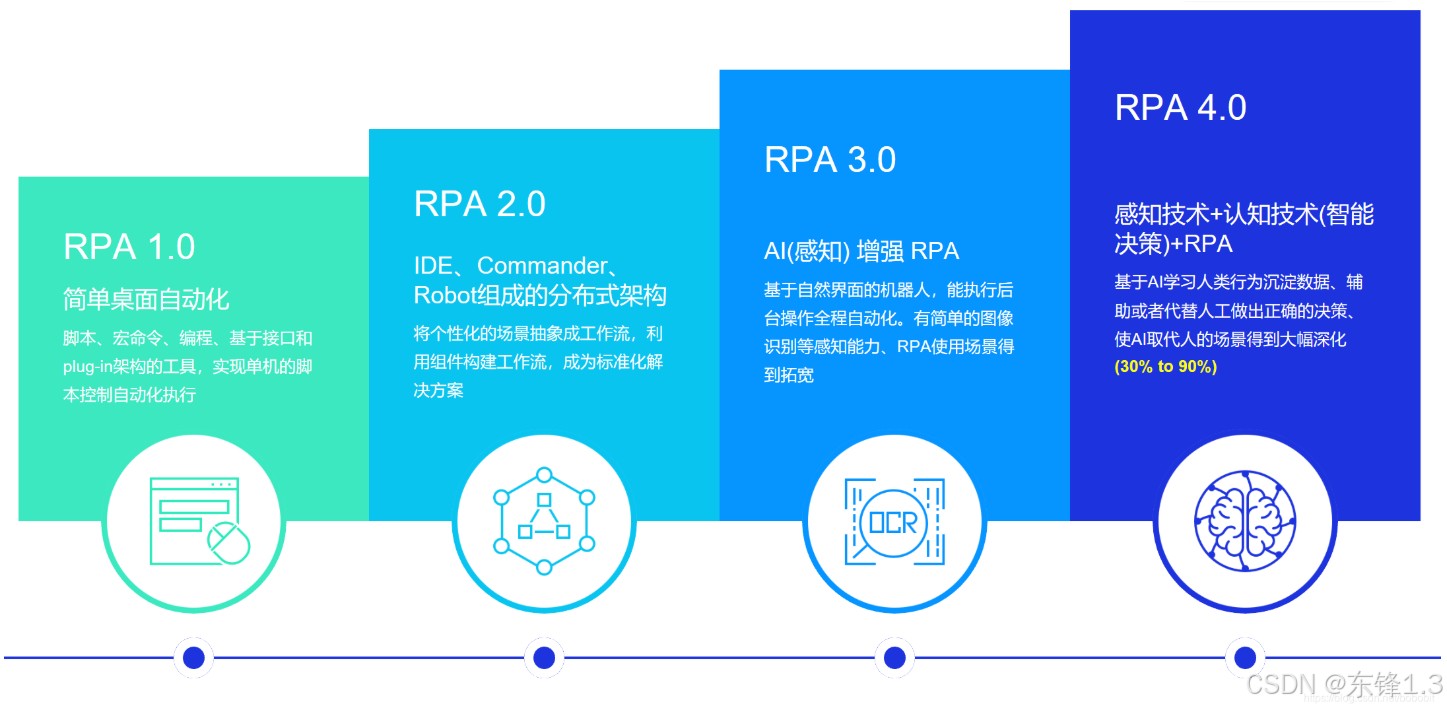
Iterative development of RPA technology
As a pharmaceutical company, R & D, production and marketing are important parts of Luye Pharma. Taking production quality as an example, their work involves a large amount of documentation and SOPs, which can find a point of integration with RPA or large AI models. As I mentioned in previous sharing sessions, domestic and foreign drug regulatory authorities are now exploring and using AI models similar to DeepSeek or ChatGPT to complete regulatory-related work. This is an inspiration for pharmaceutical companies, and we can also consider introducing related technologies to GxP-related departments and positions in the future.
Kaipu: In recent years, with the rapid development of technology, both senior management and frontline employees have a stronger understanding of, interest in, and willingness to accept these new technologies than ever before. Next, the Group is also about to fully deploy the application of AI in various business sectors, and we can take this opportunity to continue exploring related application scenarios. We hope that all business departments can actively participate in the daily training and sharing sessions of the IT Department, understand the advanced technology in the industry, and combine the actual pain points of each business department to communicate with us in a proactive manner. The IT Department will also do its best to provide technical support for everyone.
Q: The RPA project has achieved very good results and feedback so far. What do you think is the most important factor in driving the success of the project?
Haibin: I think communication is the most important thing for any project. My work requires me to communicate with different business departments, and I want to communicate with colleagues in the corresponding departments in business language. Because they don't know much about computers, we need to help them understand the role of RPA and where its boundaries lie in a way that is easy to understand during our communication. Similarly, as we cannot fully understand the work of each business unit, this requires us to engage in constant, proactive communication to ensure that projects progress smoothly and satisfactory results are achieved.
Song: I strongly agree with Haibin that effective communication during project implementation is a critical success factor. In addition, I believe that the success of a project also requires everyone in the team share the same goal and vision. Everyone needs to truly understand and recognize the practical changes and help that this new tool can bring us, so that they will be motivated to actively participate.
Fang: Yaqi is right. I think the starting point of driving a project is first because we have found some problems in our work, which have gradually become pain points in the business. At this point, we will think of finding suitable solutions to eliminate the pain points. Under such a premise, everyone will work together to promote the smooth completion of the project.
Ning: I think the key is for each department to have a clear understanding of their needs, because only by clarifying their needs can the IT Department accurately design automated processes to solve practical problems and improve efficiency. At the same time, cross-departmental collaboration and leadership support are also important factors in driving project success.
Kaipu: The success of this project is inseparable from all the project team members. During this project, each participant in the project team always provided us with very positive feedback and promptly communicated with us about the problems they encountered in the process. This has helped everyone to actively analyze and solve problems together, so we were able to successfully complete this project. Of course, the success of the project is also inseparable from the strong support of the company's senior leaders. Here, I would like to express my gratitude to all the leaders and project team members!

